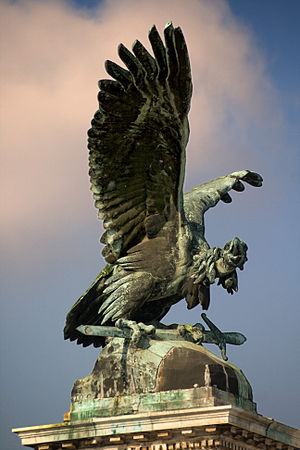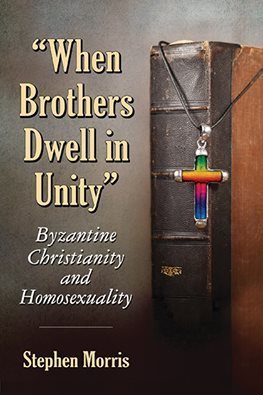Stephen Morris's Blog, page 39
March 13, 2016
Attila the Hun

St. Stephen Monument on Gellert Hill with the Liberty Bridge in the background, Budapest.
Although the king St. Stephen (pictured above, with the Liberty Bridge and it’s turul birds in the background) was baptized in Prague by the first Archbishop there and is said to have brought Christianity to the Huns and Magyars in the year 1001 A.D., the most famous of the modern Hungarian ancestors is probably Attila the Hun, who rampaged across Europe during 434-453 A.D. He and his army of Huns (a nomadic clan who came west from the area around the Caspian Sea and created an empire under Attila) terrified the peoples of Europe.
Attila himself is said to have claimed the titles “Descendant of the Great Nimrod”, and “King of the Huns, the Goths, the Danes, and the Medes”—the last two peoples being mentioned to show the extent of his control over subject nations even on the peripheries of his domain. Attila reportedly possessed the “Holy War Sword of the Scythians”, which was given to him by Mars and made him a “prince of the entire world”.
By the end of the 12th century the royal court of Hungary proclaimed their descent from Attila. Lampert of Hersfeld’s contemporary chronicles report that shortly before the year 1071, the Sword of Attila had been presented to Otto of Nordheim by the exiled queen of Hungary, Anastasia of Kiev. This sword, a cavalry sabre now in the Kunsthistorisches Museum in Vienna, appears to be the work of Hungarian goldsmiths of the ninth or tenth century.
It is an historical fact that Pope St. Leo the Great met Attila outside the walls of Rome and persuaded him to turn aside and leave the already devastated city in peace. However, according to a mediaeval Hungarian chronicle, the Pope promised Attila that if he left Rome in peace, one of his successors would receive a holy crown (which has been understood as referring to the Holy Crown of Hungary) which was in fact the crown given to St. Stephen the king (pictured above).
The post Attila the Hun appeared first on Stephen Morris, author.
March 7, 2016
Turul Birds in Budapest!

A turul bird in Budapest.
The last time I was in Budapest, I was struck by the statues of the turul birds that adorn the Liberty Bridge there. They are a striking set of images.
The turul bird is the most important bird in the origin myth of the Magyars (Hungarian people). It is a divine messenger, and perches on top of the tree of life along with the other spirits of unborn children in the form of birds. The turul became a symbol of power, strength, and nobility. The most common motifs of the ninth and the early tenth centuries — the griffin, wolf and hind — seldom figure in later Hungarian iconography and heraldic symbolism; however the hawk or turul were preserved for longer as a device belonging to the ruling house.
The Turul is probably based on a large falcon, and the origin of the word is most likely Turkic: “togrıl” or “turgul” means a medium to large bird of prey of the family Accipitridae. In Hungarian the word sólyom means falcon, and there are three ancient words describing different kinds of falcons: kerecsen (saker falcon), zongor [Turkish sungur = gyrfalcon] and turul.
I will be in Budapest for the next two weeks, participating in conferences on both fairy tales and the supernatural. Then off to Germany to see my daughter and her family. But I will keep posting here and hopefully posting photos on Facebook!
The post Turul Birds in Budapest! appeared first on Stephen Morris, author.
February 29, 2016
St. David of Wales — and his leeks!

Children wearing their St David’s Day leeks on March 1, 1957.
Many Welsh people wear one or both of the National symbols of Wales to celebrate St. David: the daffodil (a generic Welsh symbol) or the leek (Saint David’s personal symbol) on March 1. The association of leeks with St. David arises from an occasion when a troop of Welsh soldiers were able to distinguish each other from a troop of the English enemy dressed in similar fashion by wearing leeks. Leek soup is also a popular dish on March 1.
The word leek comes from the Anglo-Saxon name for the plant, leac. The leek, like its relatives the onion and garlic, has been known as a food plant for thousands of years. Over 1,200 years before Christ, the Israelites in the Sinai wilderness longed for the leeks, onions, garlic, meat and other foods they had known in Egypt (Numbers 11:4-6).
The emperor Nero ate great quantities of leeks under the delusion that they improved his voice.
Beginning in antiquity, soldiers of many centuries believed that carrying a leek in battle would assure safety and victory; this was probably why St. David told the Welsh soldiers to wear it.
Who was St. David of Wales? He is said to have been the primary evangelizer of Wales and as a member of Welsh royalty, he founded a Celtic monastic community at Glyn Rhosyn (“The Vale of Roses”) on the western headland of Pembrokeshire at the spot where St David’s Cathedral stands today. David’s fame as a teacher and ascetic spread throughout the Celtic world. The date of Saint David’s death is recorded as 1 March, but the year is uncertain – possibly 588.
Saint David was recognised as a national patron saint at the height of Welsh resistance to the Normans. Saint David’s Day was celebrated by Welsh diaspora from the late Middle Ages. Indeed, the 17th-century diarist Samuel Pepys noted how Welsh celebrations in London for Saint David’s Day would spark wider counter-celebrations amongst their English neighbors: life-sized effigies of Welshmen were symbolically lynched, and by the 18th century the custom had arisen of confectioners producing “taffies”—gingerbread figures baked in the shape of a Welshman riding a goat—on Saint David’s Day.
In 1485, Henry VII of England, whose ancestry was partly Welsh, became King of England after victory at the Battle of Bosworth Field; Henry was the first monarch of the House of Tudor and this dynasty added a Welsh dragon to the royal coat of arms, a reference to the monarch’s origins.
The post St. David of Wales — and his leeks! appeared first on Stephen Morris, author.
February 22, 2016
Forty?!?!

Our class photo just before graduation. Can you make out a familiar face in the fourth row from the top, center? :-)
FORTY years?!?! Really? I recently received a notice on Facebook that my high school classmates are organizing the 40th reunion of our Class of ’76 from Rainier Beach High School in Seattle! Can it really have been that long ago? While it may not seem quite like yesterday, it certainly doesn’t seem like 40 years ago! But I recently saw a list of other significant 40s circulate on several FB pages as well:
*Muhammad was forty years old when he first received the revelation delivered by the archangel Gabriel.
*Rain fell for “forty days and forty nights” during the Flood. (Genesis 7:4)
*Spies explored the land of Israel for “forty days.” (Numbers 13:25)
*The Hebrew people lived in the Sinai desert for “forty years”. This period of years represents the time it takes for a new generation to arise. (Numbers 32:13)
*Moses’ life is divided into three 40-year segments, separated by his growing to adulthood, fleeing from Egypt, and his return to lead his people out. (Acts 7:23,30,36)
*Several Jewish leaders and kings are said to have ruled for “forty years”, that is, a generation. Examples include Eli (1 Samuel 4:18), Saul (Acts 13:21), David (2 Samuel 5:4), and Solomon (1 Kings 11:42).
*Goliath challenged the Israelites twice a day for forty days before David defeated him. (1 Samuel 17:16)
*Moses spent three consecutive periods of “forty days and forty nights” on Mount Sinai
*One of the prerequisites for a man to study Kabbalah is that he is forty years old.
*Before his temptation, Jesus fasted “forty days and forty nights” in the Judean desert. (Matthew 4:2, Mark 1:13, Luke 4:2)
*Forty days was the period from the resurrection of Jesus to the ascension of Jesus. (Acts 1:3.
*In modern Christian practice, Lent consists of the 40 days preceding Easter. In much of Western Christianity, Sundays are excluded from the count; in Eastern Christianity, Sundays are included.
With all these significant 40s in mind, I guess a 40th class reunion isn’t so ominous after all!
The post Forty?!?! appeared first on Stephen Morris, author.
February 15, 2016
Stars and Cards: Pisces

The Wheel of Fortune and The Moon — shown here from the Tarot of Prague deck, available from Baba Studios — are both associated with Pisces.
On February 18, the Sun begins its month-long voyage through Pisces, the sign of the two fish, which is associated with the eighteenth trump of the tarot, the Moon card. Pisces is traditionally thought to be ruled by Jupiter, associated with the tenth tarot trump, the Wheel of Fortune. The more modern idea that Neptune rules Pisces leads to the astrological sign’s association with the twelfth trump of the tarot, the Hanged Man. In the ancient world, Pisces was also associated with the land of Israel and the Jewish inhabitants there.
Neptune is the ancient god of the seas, and the Moon, depicted on the eighteenth tarot trump, controls the ocean tides. Appropriately, the sign Pisces belongs to the water element. The tarot’s watery suit of Cups illustrates scenes related to love, friendship and vicissitudes of human emotions. The Moon card is often interpreted as a warning that someone is not seeing clearly or is being deluded in some way, which are negative aspects of Pisces.
As a Water sign, Pisces is characterized by empathy and expression of emotions. Pisces people are considered to be compassionate, artistic, intuitive, gentle, wise, and musical although they can also be fearful, overly trusting, sad, desire to escape reality, or want to be a victim/martyr.
Pisces, together with the Wheel of Fortune and the Moon, ask everyone: What areas in life are you not seeing clearly? Are your actions motivated by love or by desire? Do you need to act with more compassion? Are you neglecting your spirituality for material gain?
The post Stars and Cards: Pisces appeared first on Stephen Morris, author.
February 7, 2016
#StValentineDay 2016

The skull and other relics of St. Valentine, a priest martyred in Rome during the early centuries of Christianity, now kept on a side altar in the Basilica of Santa Maria in Cosmedin in Rome.
With the modern celebration of Valentine’s Day nearly upon us, can thoughts of love magic be far behind? A number of traditional ways to win another’s heart have been used over the years. One way a woman could win a man’s heart was by feeding him food into which she had mixed some of her own blood (menstrual blood was especially effective). Catching the reflection of mating birds in a mirror on Thursday was the first step in a more complicated love spell. After catching the reflection, a person would give the mirror to his or her chosen and once the receiver looked into the mirror, they would be irresistibly infatuated with the mirror-giver. Or a woman might resort to the much more simple use of caraway seeds, cloves, or coriander to win the affection of the man she had chosen. One English love potion included the kidney of a rabbit, the womb of a swallow, and the heart of a dove while an ancient Greek love potion used a stallion’s semen or a mare’s vaginal discharge.
Garlic, saffron, ginger, or even vanilla(!) were more likely to be used in erotic magic, which was less concerned with affection, and more likely to be aimed by men at women. Wax images could be pierced by pins to incite lust. Striking the intended with hazel or willow branches was also thought to inspire lust. Or you could obtain a few hairs from your intended’s head, tie them in a knot with twine, and then keep the amulet on your thigh or around your genitals to draw your intended’s attentions.
Of course, there were ways to deflect this sort of magic as well. Lily or lettuce could break love spells or decrease lust and thwart unwanted attentions. Just be sure not to confuse which herbs you feed to which guest at your table!
The post #StValentineDay 2016 appeared first on Stephen Morris, author.
January 31, 2016
St. Brigid’s Day 2016

Legend says that while St. Brigit sat alongside a dying man one night, she picked up a handful of rushes from the floor and wove a cross, explaining the Gospel to the dying man as she made the cross. Nowadays many make similar crosses and hang them up to protect their house or barn until the next February.
Saint Brigit of Kildare or Brigid of Ireland (c. 451–525) is one of Ireland’s patron saints, along with Patrick and Columba. Irish hagiography makes her an early Irish Christian nun, abbess, and founder of several monasteries of nuns, including that of Kildare in Ireland, which was famous and was revered. Her feast day is 1 February, which was formerly celebrated as a pagan festival (Imbolc) marking the beginning of spring and the lambing season.
Once a leprous woman asked her for milk, but there was none available so St. Brigid gave her cold water instead. The water turned into milk and when she had drunk it, the woman was healed.
Like her mentor St. Patrick, Brigid was fond of ale and is reputed to have been the best brewer in the land. She supplied beer out of one barrel to eighteen different churches. This single barrelful not only supplied these eighteen different churches, but each church had enough ale to last from Maundy Thursday until Trinity Sunday.
One of the most prettiest legends concerning Saint Brigid tells us that another version of her name was “Bride” and as “St. Bride” she was the patroness of the Knights of Chivalry. They began the custom of calling the girls they each married their own “brides” or “Brigits;” and that from the Knights of Chivalry the word bride came into general usage in the English language.
In very traditional homes, two devout practices are still observed on the Eve of St. Brigid’s Feast Day (February 1st). A strip of cloth called “brat Bhride” (Brigid’s mantle) is hung outside the door. A loaf of oat bread baked in the shape of a cross and a sheaf of straw are left on the windowsill. For on that night, Brigid travels through the land with her red-eared cow bestowing blessings on those who keep the old ways.
The post St. Brigid’s Day 2016 appeared first on Stephen Morris, author.
January 25, 2016
The 3 Hierarchs

An icon depicting the three hierarchs: Basil the Great, John Chrysostom, and Gregory the Theologian.
In “The Song of Roland,” the hero Roland wields a sword said to contain within its golden hilt one tooth of Saint Peter, blood of Saint Basil (one of the 3 hierarchs), a hair of Saint Denis, and a piece of the raiment of the Blessed Virgin Mary; the sword is therefore reported to be the sharpest sword in all existence.In the poem, Roland uses the sword to hold off a hundred-thousand-strong Muslim army — the perennial enemies of Byzantium as well — long enough for Charlemagne’s army to retreat into France.
Roland attempted to destroy the sword to prevent it from being captured by the attacking Saracens and created La Brèche de Roland in the Pyrenees in the process. But the sword proved indestructible, so he hid it beneath his body along with the oliphant, the horn used to alert Charlemagne.
Local folklore claims that the sword still exists, preserved in Rocamadour, France, embedded in a cliff wall. In the twelfth century, the monks of Rocamadour claimed that Roland threw the sword at the cliff rather than hid it beneath himself.
The Three Hierarchs of Eastern Christianity refers to Basil the Great (also known as Basil of Caesarea), Gregory the Theologian (also known as Gregory of Nazianzus) and John Chrysostom. They were highly influential bishops of the early church who played pivotal roles in shaping Christian theology. In Eastern Christianity they are also known as the Three Great Hierarchs and Ecumenical Teachers, while in Roman Catholicism the three are honored as Doctors of the Church. The three are venerated as saints in Eastern Orthodoxy, Catholicism, Anglicanism and other Christian churches.
The post The 3 Hierarchs appeared first on Stephen Morris, author.
January 19, 2016
Weight Watchers and Fairy Tales

The Viewmaster depiction of Hansel and Gretel, the witch, and her gingerbread house were among my favorite childhood illustrations of one of my favorite fairy tales.
I started the Weight Watchers program in late November because I refuse to buy new clothes — everything I own was getting too snug! I had always refused to dignify weight loss efforts in the past by going to Weight Watchers but this time I finally capitulated. It couldn’t hurt to give it a shot, right? So far, I have lost about 25% of my excess weight on the Weight Watchers program and aim to keep losing more until I reach my “goal” weight — and all my clothes fit properly again.
The “fat and jolly old elf” of A Visit From St. Nicholas is a kindly old gentleman who is well-disposed toward others. But he is the exception.Overweight people appear in fairy tales but the image of “overweight,” often tied to “jolly,” is not always so innocent. Overweight people, in the world that give rise to fairy tales, were often wealthy and their weight indicated just how wealthy — and lazy? they had too many servants as well as too much food — they were.
But sometimes being overweight as a code word for “greedy.” The giants in fairy tales (such Jack and the Beanstalk or Jack the Giant-killer, etc.) were also greedy and lazy as well as large and heavy.
Hansel and Gretel wanted to eat the witch’s house and were rewarded for their efforts by her attempts to eat them! Hansel hid his obesity from the witch by using an old, dry chicken(?) bone he found at the bottom of his cage rather than his own finger when she wanted to check his growing weight.
Hansel and Gretel were not the only ones to discover the dangers of eating the food of a witch. Folk tales from all over the world warn that eating the food of a witch, a demon, a djinn, a troll, an ogre, or the faeries can be a dangerous proposition. You might owe your youngest child in return, or be bound to your host for the rest of your life.
Hopefully, the Weight Watchers program will save me from all these possible fates. Fingers crossed — but all bets are off if I find a gingerbread house in Central Park!
The post Weight Watchers and Fairy Tales appeared first on Stephen Morris, author.
January 6, 2016
When Brothers Dwell in Unity is now available!
I didn’t think the book would be available so soon — but it’s out NOW! Huzzah! #WhenBrothersDwell
Click here to order yours today!
The post When Brothers Dwell in Unity is now available! appeared first on Stephen Morris, author.




